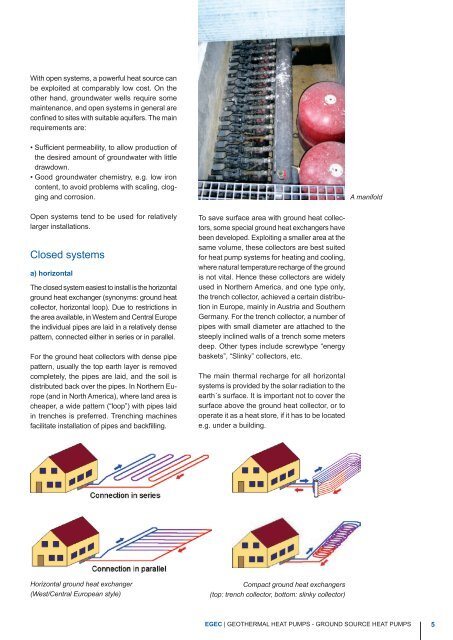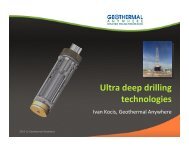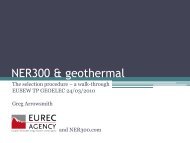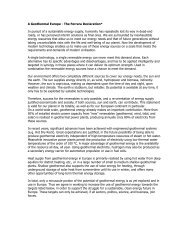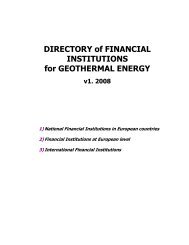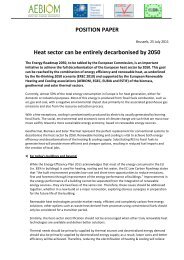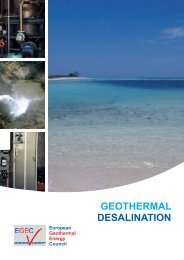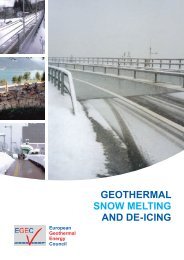GEOTHERMAL HEAT PUMPS - GROUnd SOURCE HEAT ... - EGEC
GEOTHERMAL HEAT PUMPS - GROUnd SOURCE HEAT ... - EGEC
GEOTHERMAL HEAT PUMPS - GROUnd SOURCE HEAT ... - EGEC
Create successful ePaper yourself
Turn your PDF publications into a flip-book with our unique Google optimized e-Paper software.
With open systems, a powerful heat source can<br />
be exploited at comparably low cost. On the<br />
other hand, groundwater wells require some<br />
maintenance, and open systems in general are<br />
confined to sites with suitable aquifers. The main<br />
requirements are:<br />
• Sufficient permeability, to allow production of<br />
the desired amount of groundwater with little<br />
drawdown.<br />
• Good groundwater chemistry, e.g. low iron<br />
content, to avoid problems with scaling, clogging<br />
and corrosion.<br />
A manifold<br />
Open systems tend to be used for relatively<br />
larger installations.<br />
Closed systems<br />
a) horizontal<br />
The closed system easiest to install is the horizontal<br />
ground heat exchanger (synonyms: ground heat<br />
collector, horizontal loop). Due to restrictions in<br />
the area available, in Western and Central Europe<br />
the individual pipes are laid in a relatively dense<br />
pattern, connected either in series or in parallel.<br />
For the ground heat collectors with dense pipe<br />
pattern, usually the top earth layer is removed<br />
completely, the pipes are laid, and the soil is<br />
distributed back over the pipes. In Northern Europe<br />
(and in North America), where land area is<br />
cheaper, a wide pattern (“loop”) with pipes laid<br />
in trenches is preferred. Trenching machines<br />
facilitate installation of pipes and backfilling.<br />
To save surface area with ground heat collectors,<br />
some special ground heat exchangers have<br />
been developed. Exploiting a smaller area at the<br />
same volume, these collectors are best suited<br />
for heat pump systems for heating and cooling,<br />
where natural temperature recharge of the ground<br />
is not vital. Hence these collectors are widely<br />
used in Northern America, and one type only,<br />
the trench collector, achieved a certain distribution<br />
in Europe, mainly in Austria and Southern<br />
Germany. For the trench collector, a number of<br />
pipes with small diameter are attached to the<br />
steeply inclined walls of a trench some meters<br />
deep. Other types include screwtype “energy<br />
baskets”, “Slinky” collectors, etc.<br />
The main thermal recharge for all horizontal<br />
systems is provided by the solar radiation to the<br />
earth´s surface. It is important not to cover the<br />
surface above the ground heat collector, or to<br />
operate it as a heat store, if it has to be located<br />
e.g. under a building.<br />
Horizontal ground heat exchanger<br />
(West/Central European style)<br />
Compact ground heat exchangers<br />
(top: trench collector, bottom: slinky collector)<br />
<strong>EGEC</strong> | <strong>GEOTHERMAL</strong> <strong>HEAT</strong> <strong>PUMPS</strong> - GROUND <strong>SOURCE</strong> <strong>HEAT</strong> <strong>PUMPS</strong> 5


